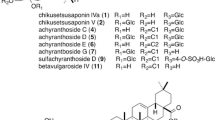Abstract
1H-NMR spectroscopy was successfully applied to the quantitative determination of atractylon in Atractylodis Rhizoma (dried rhizomes of Atractylodes ovata and A. japonica) and Atractylodis Lanceae Rhizoma (dried rhizomes of Atractylodes lancea and A. chinensis). The analysis was carried out by comparing the integral of the H-12 singlet signal of atractylon, which was well separated in the range of δ 6.95–7.05 ppm in the NMR spectrum, with the integral of a hexamethyldisilane (HMD) signal at δ 0 ppm. The atractylon contents obtained by the 1H-NMR spectroscopy were consistent with those obtained by the conventional HPLC analysis. The present method requires neither reference compounds for calibration curves nor sample pre-purification. It also allows simultaneous determination of multiple constituents in a crude extract. Thus, it is applicable to chemical evaluation of crude drugs as a powerful alternative to various chromatographic methods.



Similar content being viewed by others
References
Prieto JM, Recio MC, Giner RM, Máñez S, Giner-Larza EM, Ríos JL (2003) Influence of traditional Chinese anti-inflammatory medicinal plants on leukocyte and platelet functions. J Pharm Pharmacol 55:1275–1282
Wang KT, Chen LG, Yang LL, Ke WM, Chang HC, Wang CC (2007) Analysis of the sesquiterpenoids in processed Atractylodis Rhizoma. Chem Pharm Bull 55:50–56
Wang CC, Chen LG, Yang LL (2002) Cytotoxic activity of sesquiterpenoids from Atractylodes ovata on leukemia cell lines. Planta Med 68:204–208
Kim HK, Yun YK, Ahn YJ (2007) Toxicity of atractylon and atractylenolide III identified in Atractylodes ovata rhizome to Dermatophagoides farinae and Dermatophagoides pteronyssinus. J Agric Food Chem 55:6027–6031
Satoh K, Nagai F, Ushiyama K, Kano I (1996) Specific inhibition of Na+,K+-ATPase activity by atractylon, a major component of Byaku-jutsu, by interaction with enzyme in the E2 state. Biochem Pharmacol 51:339–343
Ministry of Health and Welfare (2000) The Japanese Pharmacopeia, 15th edn, Japan, pp 11–12; see also pp 13–14
Alberti F, Belton PS, Gil AM (2002) Application of NMR to food science. Annu Rep NMR Spectrosc 47:109–148
Tahara M, Sugimoto N, Suematsu T, Arifuku K, Saito T, Ihara T, Yoshida Y, Tada A, Kubota R, Shimizu K, Yamazaki T, Tanamoto K, Nakazawa H, Nishimura T (2009) Quality control of organophophorous isoxanthion oxon based on qNMR. Jpn J Food Chem Safety 16:28–33
Pauli GF, Jaki BU, Lankin GC (2005) Quantitative 1H NMR: development and potential of a method for natural products analysis. J Nat Prod 68:133–149
Guo Y, Kondo K, Terabayashi S, Yamamoto Y, Shimada H, Fujita M, Kawasaki T, Maruyama T, Goda Y, Mizukami H (2006) DNA authentication of So-jutsu (Atractylodes lancea rhizome) and Byaku-jutsu (Atractylodes rhizome) obtained in the market based on the nucleotide sequence of the 18S–5.8S rDNA internal transcribed spacer region. J Nat Med 60:149–156
Zhao C, He C (2006) Preparative isolation and purification of atractylon and atractylenolide III from the Chinese medicinal plant Atractylodes macrocephala by high-speed counter-current chromatography. J Sep Sci 29:1630–1636
Saito T, Ihara T, Koike M, Kinugasa S, Fujimine Y, Nose K, Hira T (2009) A new traceability scheme for the development of international system-traceable persistent organic pollutant reference materials by quantitative nuclear magnetic resonance. Accred Qual Assur 14:79–86
Takeda O, Miki E, Morita M, Okada M, Lu Y, He SA (1994) Variation of essential oil components of Atractylodes lancea growing in Mt. Maoshan area in Jiangsu Province, China. Nat Med 48:11–17
Kohda H, Goto K, Anetai M, Yamagishi T (1994) Studies on the botanical origin of Atractylodes lancea “Cang Zhu”. Nat Med 48:58–62
Mizukami H, Shimizu R, Kohda H, Kohjyouma M, Kawanishi F, Hiraoka N (1996) Restriction fragment length polymorphisms of rDNA and variation of essential oil composition in Atractylodes plants. Biol Pharm Bull 19:577–580
Acknowledgments
We would like to thank Dr. Y. Yamamoto, Tochimoto tenkaido Co., Ltd., and Dr. M Fujita, Uchida Wakanyaku Co., Ltd., for providing us with crude drug samples of Atractylodis Rhizoma and Atractylodis Lanceae Rhizoma. This work is supported by Grant-in-Aid for Scientific Research from the Ministry of Health, Welfare and Labor of Japan.
Author information
Authors and Affiliations
Corresponding author
Rights and permissions
About this article
Cite this article
Hasada, K., Yoshida, T., Yamazaki, T. et al. Quantitative determination of atractylon in Atractylodis Rhizoma and Atractylodis Lanceae Rhizoma by 1H-NMR spectroscopy. J Nat Med 64, 161–166 (2010). https://doi.org/10.1007/s11418-010-0393-x
Received:
Accepted:
Published:
Issue Date:
DOI: https://doi.org/10.1007/s11418-010-0393-x




